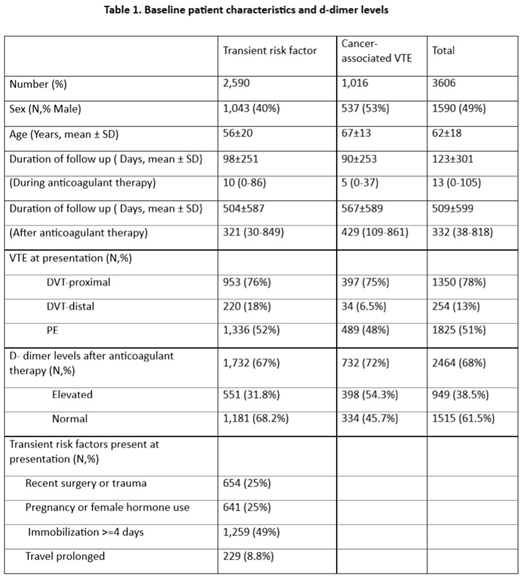Abstract
Background. Patients with venous thromboembolism (VTE) secondary to transient risk factors or cancer may develop VTE recurrences after discontinuing anticoagulant therapy. Identifying at-risk patients could help to guide the ideal duration of anticoagulant therapy in these patients.
Methods. We used the RIETE database to assess the prognostic value of d-dimer testing after discontinuing anticoagulation to identify patients at increased risk for recurrences. The proportion of patients with raised d-dimer levels was determined and the hazard ratio (HR) for VTE recurrences compared to those with normal levels was calculated. Univariate and multivariate analyses of factors associated with VTE recurrence were performed.
Results. 3 606 patients were identified in the database in April 2018: 2 590 had VTE after a transient risk factor and 1016 had a cancer. D-dimer levels were measured after discontinuing anticoagulation in 1 732 (67%) patients with transient risk factors and 732 (72%) patients with cancer-associated VTE and these patients formed the cohort in which recurrent VTE rate was calculated. D-dimers and were elevated in 551 (31.8%) of patients with a transient risk factor and were normal in 1181 (68.2%). In the cancer-associated group, d-dimers were elevated in 398 (54.3%) and normal in 334 (45.7%) patients. The adjusted hazard ratio for recurrent VTE was: 2.32 (95%CI: 1.55-3.49) in patients with transient risk factors and 2.23 (95%CI: 1.50-3.39) in those with cancer.
Conclusions. Patients with raised d-dimer levels after discontinuing anticoagulant therapy for provoked or cancer-associated VTE are at increased risk for recurrent VTE and death. Future studies could target these patients for extended anticoagulation.
No relevant conflicts of interest to declare.
Author notes
Asterisk with author names denotes non-ASH members.


This feature is available to Subscribers Only
Sign In or Create an Account Close Modal